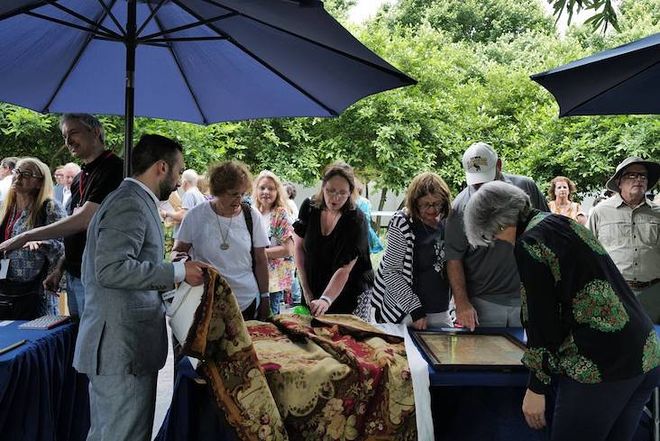
Expert William DeGregorio (left) appraising at the rugs and textiles table at ANTIQUES ROADSHOW’s event at the North Carolina Museum of Art in Raleigh, NC. Photo by Meredith Nierman for GBH, (c) WGBH 2023.
Antiques Roadshow, PBS’s most-watched ongoing series, is currently in its twenty-seventh season, reaching about five million people each week. The show also happens to have strong ties to Bard Graduate Center. Advertised as “Part adventure, part history lesson, part treasure hunt,” the show takes a group of about seventy appraisers to various small cities in the United States and invites locals to bring two objects—be they antiques, family heirlooms, or knick knacks—for a free appraisal. In addition to assigning monetary value to items, interesting stories about family, makers, and cultural histories often emerge, and the show provides a platform for both amateurs and experts to tell these stories.
Unsurprisingly, several members of the Bard Graduate Center community have appeared on the show as appraisers, such as BGC board chair Nancy Druckman, BGC PhD candidate Martina D’Amato, and BGC MA ’12 and PhD ’21 William DeGregorio. Druckman, a pioneer in the field of American folk art, directed the department at Sotheby’s for more than forty years and now offers appraisals and advises collectors, museums, and colleagues on buying, selling, donating, documenting, and conserving art through her company, Nancy Druckman Art; D’Amato, whose dissertation centers on the social and political impulses behind the medieval and Renaissance art collections of two figures in Franco-Italian collecting history—Louis Carrand (1827–88) and the Marchioness Arconati-Visconti (1840–1923)—is the managing director at Cora Ginsburg; DeGregorio co-authored The Percival D. Griffiths Collection: English Furniture 1680 - 1760 and English Needlework 1600–1740 (Yale University Press) and has recently been named associate curator at the Costume Institute at the Metropolitan Museum of Art. These three connoisseurs shared their experiences, behind-the-scenes tidbits, and the most exciting things they encountered while on the road with Antiques Roadshow over lunch at the Consulate, a favorite restaurant near BGC’s West 86th Street home.
Druckman was recruited to be on the show in its first year after then-executive producer Aida Moreno came by Sotheby’s and had her give an impromptu presentation on an eighteenth-century embroidered chimneypiece created by Hannah Otis. Since then, Druckman has appeared on the show every year from 1996 through 2022. D’Amato was invited to participate for the second time, DeGregorio the first, this year because they worked for antique costume and textile dealer Titi Halle at Cora Ginsburg (a gallery established in 1971 that specializes in historical fashion and textiles from the sixteenth to twentieth centuries). Halle, who has a longtime relationship with BGC as a lender to its exhibitions and a mentor to its students, also appeared on the show when it first started and recommended that senior producer Sam Farrell reach out to them.
Druckman, D’Amato, and DeGregorio shared some insights as to how a typical day of filming Antiques Roadshow goes: The day starts early, with appraisers arriving at 6 am. Those who apply to be on the show and are lucky enough to score one of the limited free tickets bring their items to the filming location around 7 am and are then sent to a specialist based on what they’ve brought in. The team agreed that most objects brought onto the show fall into the categories of decorative arts, Asian arts, paintings, and collectibles. As all three are experts on textile and fashion history, they bemoaned the fact that few guests bring in things falling into that category. Druckman said that for appraisers, each day of filming can be up to thirteen hours long. Appraisers are generally a combination of people who work at auction houses and independent dealers. Having experience encountering many kinds of objects (as one would in an auction house) is helpful, but D’Amato, Druckman, and DeGregorio feel there’s no way to prepare for appraising objects on Antiques Roadshow because it’s impossible to know what to expect. D’Amato credited the broad range of classes she was able to take at Bard Graduate Center in preparing her and believes she could not “do this kind of work without having some generalized knowledge.”
DeGregorio explained that specialists are responsible for pitching objects they find particularly interesting to producers in the hopes that they’ll be filmed and included in an episode. Druckman called the experience “the ultimate Skinnerian experiment—the dog never knows when the treat is going to come out of the trap. You’re constantly on edge waiting for that moment.” An object that would make for good television is often one that’s worth a lot of money or has a good story attached to it. To make for a “big wow” moment, specialists try to tell guests as little as possible about their object before filming. DeGregorio reflected, “I think [the producers] are increasingly interested in telling stories, so they’re not just interested in something that’s worth a lot of money, but they’re interested in telling stories about objects that might not have been told in the past.” D’Amato added, “They definitely want to show the diversity of people who come to these events. It’s a huge swath of America, and you’re seeing every level of object from every possible person. I’ve learned that an interesting story—something that will say something special on television—is better than a high price.” Appraisers do have a couple hours between pitching an object and filming its appraisal to do more research, and Druckman especially noted that having the internet at one’s fingertips has been helpful, as she used to bring “a library” on the road with her but now she can easily pull the information she needs from various websites. D’Amato has used Etsy to get a sense of the market for lower value objects like compact cases and purses. She has also learned a lot from other dealers and specialists, whom she has often asked for advice or a second opinion. She said, “I think it’s arguable that people in the market know as much as academics, especially about objects like this. I’d like to think that the differentiation and ostracization of dealers in relation to academic scholarship and curatorial work is changing.” D’Amato’s thinking on this point reflects BGC’s long standing appreciation of dealers and appraisers; each year BGC bestows one of its Iris Foundation Awards to an outstanding dealer.
When asked about memorable objects they had come across while appraising on Antiques Roadshow, Druckman remembered a woman in Nashville, Tennessee who brought in a framed print and wanted the frame appraised: “To examine the frame, they had to take the print out, and under the print was a Sheldon Peck portrait. Peck was a Vermont artist in the 1820s and 30s who was an abolitionist and migrated to Illinois. His home was a stop on the Underground Railroad. And the portrait looked so fresh that you almost wanted to touch it to see if the paint had dried. The rag content in the paper was so high that the paper never degraded, and the print protected the integrity of the paper. And that was just an insane moment.” DeGregorio and D’Amato wistfully recalled a group of Knoll fabrics from the sixties, brought in by a volunteer in Baton Rouge, Louisiana, that they still regret not pitching to the producers. D’Amato also mentioned that one of her favorite things she appraised this season is a Connecticut quilt made in 1848: “It was beautiful. It was an album quilt showing all the towns surrounding Putnam, Connecticut. It was in great condition, and it was really about showing off these British cottons that were just so modern…I’m not normally a quilt person, but that was really exciting to see.” Druckman added, “You could do a whole sort of master’s thesis about the migration of these objects. I did a Roadshow in Honolulu, and there was a Folwell school, Philadelphia early nineteenth-century silk embroidered picture. So, there’s the question, how did this get there? But of course, Hawaii has a big retirement community and the things that are most important to a family migrate with them.” As for items they want to see on the show in the future, De Gregorio “would love to see a Charles James dress come out of a bag,” and D’Amato said, “Going back to what I study at BGC, I would love to see some fragments of Renaissance fabrics…maybe some velvets, something fun that you don’t normally see.”
Although appraisers don’t get paid and must work long days when filming, these alumni find the experience of being on Antiques Roadshow to be worthwhile as it provides an opportunity for them to encounter a wide array of objects that they might not find elsewhere and share their stories with the public. DeGregorio reflects, “Viewers might not be interested in a really academic perspective on things, but if you can teach them where this object comes from and how it got here, and maybe why it’s worth a lot of money, or not, then that makes good television. And it’s really an educational program. You’re trying to educate as well as entertain. So, putting that information out there, that’s always very rewarding.”

